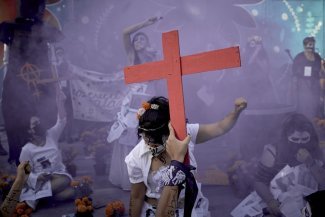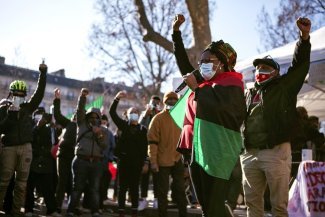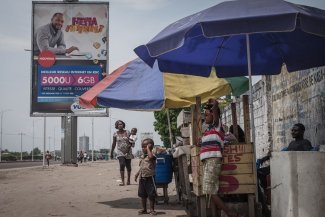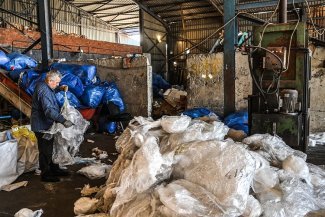The Subway sandwich shop at Porte d’Orléans in Paris, squeezed between a bank and a boutique, was crowded when I visited one day in July. People finished their meal in under 15 minutes, as there was little encouragement to linger: the neon-lit shop was stifling in the hot weather and there was a din of techno music.
Along Avenue du Général-Leclerc, there is a Buffalo Grill, another Subway, a McDonald’s and a Burger King, before you get to the huge windows and mermaid logo of the Starbucks. It contrasts with the Subway — the walls are painted in warm colours, the music is jazzy, the tables and sofas welcoming, there are sockets for laptops: everything to encourage customers to stay as long as they like.
With their established US networks and niches in the global fast-food market, Subway arrived in France in 2001 and Starbucks in 2004. Unlike the multinational Burger King, quoted on the stock exchange, with franchises often held by big middlemen, Subway is a network of small entrepreneurs (the “Subway family”), presented as close to their workforce and supportive of community projects. And unlike McDonald’s and Kentucky Fried Chicken (KFC), with their high-fat food, Subway claims to offer “healthy” products.
Starbucks wants to be seen as upmarket and responsible, and emphasises the freshness of its sandwiches, cakes and juices and the skill of its coffee roasters. It boasts of its fair trade coffee and good staff management. According to its charter, its employees are ‘partners’: “It’s not just a job, it’s our passion. Together, we embrace diversity to create a place where each of us can be ourselves. We always treat each other with respect and dignity. And we hold each other to that standard,” Starbucks CEO Howard Schultz has claimed. He is responsible for 21,000 Starbucks outlets in 60 countries, with a workforce of over 200,000.
“They decide, and we implement”
Schultz bought Starbucks in 1987 for US$4 million, when it was a local Seattle chain created by two coffee lovers. Since then, through books and media appearances, he has worked to build its legend. He misses no opportunity to show his support for progressive causes: President Obama’s healthcare policies, same-sex marriage, a ban on carrying guns and free online courses for its employees, etc.
His counterpart at Subway, Frederick DeLuca, is also a favourite with the US media, as a self-made man. In 1965, aged 17, he opened his first restaurant in Connecticut with a US$1,000 loan from a friend of his father’s, Dr Peter Buck, who still co-owns the brand. The concept — sandwiches freshly prepared to order — was an almost instant hit. By 1974, DeLuca and Buck had 16 US outlets and took the franchise route.
Since then, Subway, with 44,000 outlets in 105 countries, has overtaken McDonald’s as the fast food chain with the greatest number of outlets, though McDonald’s has a higher turnover. DeLuca, as head of a network of small entrepreneurs, vociferously defends his “family” and criticises laws that hamper small business. He is against Obamacare (“the biggest concern of our franchisees”), payroll tax and any increase in the minimum wage (“it will cause franchisees to raise prices”).
To grow in the United States and then worldwide, Subway devised an attractive model. Initial franchise costs are modest: US$11,000 (€10,000) in France, US$15,000 in the United States, a third of what competitors charge.
Opening an outlet does not entail high investment: US$220,000 of which US$88,000 is equity. There is no need for fryers, big kitchens, ice or soft drinks machines; just a toaster, a counter to display the food and a chiller for drinks.
Franchisees, who bear the full risk of failure, pay Subway 12.5 per cent of their turnover (compared to 11 per cent for KFC and Pizza Hut and 7 per cent at Pomme de Pain and Planet Sushi). Head office banks the returns, takes care of marketing and sends inspectors to check that every shop sticks to its specifications. “They decide, and we implement,” a Danish franchisee said. “If we introduced a change without informing Subway’s development agent, we’d be in trouble,” another told me.
Probably because of a confidentiality clause, most franchisees refuse to talk about their contracts. One, who runs a shop in the Lille area and agreed to speak anonymously, complained about Subway’s royalty demands: “You have to pay them every week, even when business is bad. It’s easy to get into debt. Especially as you have to deal with the brand’s official suppliers and there’s no room for manoeuvre on prices.”
Bankruptcies are common. According to Capital magazine, between 2008 and 2010, 45 per cent of French Subways changed hands.
The pressure put on shop managers is passed on to their staff. According to a CNN investigation using data from the US Department of Labor, US outlets committed 17,000 labour regulation violations between 2000 and 2013: unpaid overtime, illegal withholding of pay in cases of till shortfalls, unfair dismissal.
DeLuca blamed his franchisees, saying these were cases of “violations at the store level...three or four years ago, we started working closely with the Department of Labor to partner with them to help educate our owners on the right thing to do.”
Subway employees have few ways of standing up to their bosses: “They are very small businesses with just a few employees, and it’s almost impossible to unionise,” said Olivier Guivarch, responsible for the hotel, tourism and restaurant sectors at the French Democratic Confederation of Labour (CFDT).
Subway, with its haphazard development strategy, opens restaurants indiscriminately; Starbucks advances town by town, concentrating on places with a good flow of people — main streets, shopping centres, business districts, historic town centres, stations and airports — which it saturates to stifle competition.
Starbucks customers are supposed to be getting more than a simple drink, identical from Dubai to Rio de Janeiro — it is meant to be a gastronomic experience.
The use of Italian(ate) names (latte, macchiato, Frappuccino), the rule that baristas must throw away any espresso that has remained unmixed for longer than 10 seconds because it will have lost its flavour, and the promotional brochures reinforce the idea that the products, cleverly balanced between scientific precision and passion, can only be appreciated by discerning people. This is how it taps into a similar clientele the world over: well-off students, professionals, tourists and expats, who view it both as a familiar refuge and a distinctive destination where they can exercise their good taste.
Greenwashing
DeLuca claims to have invented the healthy fast-food business. By presenting itself this way, Subway penetrated the health-conscious market and opened up markets closed to its fried-food competitors, including hospitals, high schools and university campuses.
This greenwashing was profitable: between 1998 and 2011, according to USA Today, Subway’s US sales went from US$3.1 billion to US$11.5 billion.
But food is not “healthy,” “natural” or “fresh” just because it’s raw. Subway vegetables are tasteless, grown year round in overheated greenhouses, and picked when barely ripe (or still green) to allow time for transport. A sign in each outlet advises that sliced ham, turkey and beef are not recommended for people who are allergic to milk and soya — the meats come from factories where animals are just materials combined and transformed with water, salt, sugar, stabilisers.
Starbucks’ repositioning at the forefront of ethical business was motivated by the fact that Schultz and his strategists were worried they would become a symbol of imperialism like McDonald’s and Nike.
In 2000 Starbucks signed a partnership with TransFair USA, which promotes fair trade.
In 2004 it established its own ethical label, undertaking to pay 20-30 per cent above the market rate for coffee, and set a floor below which it would not go if market prices fell sharply. It improved workers’ benefits: in the United States, they can get health insurance (if they work more than 20 hours a week), buy shares at a discount (after a year’s service) and take home one free pack of coffee a week.
But these policies do little to really reduce Starbuck’s aggressive global policy towards suppliers and employees.
Between 1991 and 2013, global coffee sales went from US$30bn to US$70bn, but the share that went to producers dropped from 40 per cent to 10 per cent. Starbucks contributed to that change.
It has had lobbyists in Washington since 2004, pushing for lower customs barriers with its supplier countries. In 2006-2007, it brought Ethiopia before the US courts to stop the country trademarking the names of three coffee regions. To avoid paying tax on profits in countries in which it operates, it transfers the money to tax havens through a company in Switzerland. As a member of the powerful Grocery Manufacturers Association, along with Nestlé, Kraft Foods, Proctor & Gamble, it promotes free trade. It acts like every other multinational in the agribusiness sector.
Its baristas, like Subway’s “sandwich artists,” have to take orders, encourage customers to spend more, prepare drinks, operate the till, clean tables and toilets, empty bins, wash up and smile, for a wage only just above the minimum, tips included.
To Starbucks, employees are interchangeable. “If another shop needs someone extra, or if we’re overstaffed, the store manager can easily tell you to go and help out elsewhere,” a Parisian barista said. “In our contracts there’s a mobility clause: they can ask you to make a permanent change of shop, and full-time employees don’t have the right to refuse.”
There’s strong pressure to stop workers voicing their opinions. In 2005 Daniel Gross, a New York barista who wanted to create an Industrial Workers of the World (IWW) chapter in his shop, talked to the New York Times. Schultz immediately sent an email to all his US workers taking issue with Gross’ position; Gross was sacked a few months later.
Since then Starbucks has fiercely opposed unionisation, or ensured it is not troublesome. In 2013 the first elections of workers’ representatives in Starbucks France were a victory for the CFDT, but when I tried to contact two of its representatives, one, a Paris store manager said he was unavailable for several weeks and the other, a shift supervisor, didn’t want to speak without management approval.
High staff turnover, small-scale operations, franchising system and hierarchy make it difficult to organise the workforce in the fast-food sector.
In 2014 union delegates from more than 30 countries met in New York to discuss collective action. They listened to the experiences of New Zealand’s Unite organisation, one of the few firmly established in the sector. In 2005 Unite activists burst into a Starbucks in Auckland and called on the baristas to stop work.
This was repeated in other shops, and in less than six months, 2,000 people had signed up to the union, which kept up its interventions (such as saturating a company’s phone switchboard with calls to disrupt its delivery system). The fast-food giants gave in, and in 2006 a collective agreement was signed.
Since then, more than 30,000 young workers have entered the union and wages in New Zealand’s fast-food sector have increased by 50 per cent.
The unedited version of this article was initially published in Le Monde diplomatique. Copyright ©2015 Le Monde diplomatique. Used by permission of Agence Global









